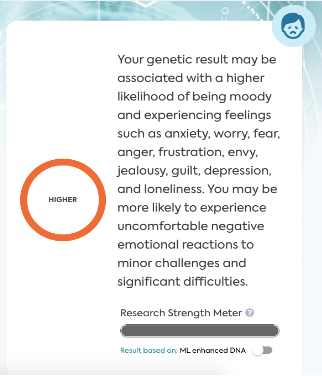Hypnotizability: Decoding Individual Responses through Genetics
harvey
on
March 1, 2024
Latest Posts
Table of Contents
Hypnotizability: Decoding Individual Responses through Genetics
Date of Content: February 14, 2024
Written by: Harvey Talento
Reviewed by: Maarit Tiirikainen, PhD
Hypnosis has long captured the imagination, often depicted in movies as a mysterious way to control minds. While film portrayals tend to be exaggerated, hypnosis is a real phenomenon with various applications. However, not everyone experiences it the same way. This is where hypnotizability comes in.
What is Hypnotizability?
Hypnotizability is the individual ability to respond to hypnotic suggestions. This includes experiencing changes in:
- Physiology: This could involve heart rate, breathing, or temperature.
- Sensations: A person may feel lighter or heavier or even experience vivid imagery.
- Emotions: Hypnotic suggestions can influence mood or emotional state.
- Thoughts: A person might become more open to accepting suggestions or engaging in creative thinking.
- Behavior: In some cases, hypnosis can lead to automatic responses or behaviors triggered by suggestions.
Moreover, hypnosis is a technique used to heighten a person’s focus, create a sense of calm, and allow the person to be more receptive to suggestions by the hypnotist.

How Does Hypnosis Work?
Hypnosis isn’t about mind control. Instead, it’s a process of inducing deep relaxation and focused concentration. Here’s a breakdown of what happens:
Entering the Hypnotic State
- A trained hypnotherapist guides you using verbal cues, repetition, and sometimes imagery.
- This helps you enter a state like being deeply absorbed in a book or movie, where your focus narrows and distractions fade.
- Importantly, you remain fully aware and in control throughout the process.
Increased Focus and Openness
- This state of focused attention allows you to be more receptive to suggestions from the hypnotherapist.
- These suggestions can target aspects like managing anxieties, changing habits, or reducing pain perception.
The Science Behind It
- While the exact mechanisms are still being explored, research suggests hypnosis impacts brain activity in several ways:
- Increased activity in areas related to focus and attention.
- Decreased activity in areas associated with self-awareness and critical thinking.
- Activation of regions controlling relaxation and emotional regulation.
Overall, hypnosis is a collaborative process between the hypnotherapist and the participant. Creating a state of focused relaxation and heightened suggestibility aims to bring about positive changes in a person’s thoughts, feelings, and behaviors.
What Research Says
A 2016 research study sheds light on the neural mechanisms at play during hypnosis. This includes the activation of brain regions responsible for controlling physical actions and sensations. Interestingly, individuals under hypnosis exhibit reduced activity between the brain regions guiding action and awareness of actions. This dissociation makes individuals more susceptible to external commands, enabling them to act without reservations or self-consciousness.
Moreover, the study unveiled an intriguing finding: those who can be hypnotized can learn self-hypnosis. This means they can independently enter hypnotic states without relying on an external hypnotist, providing a degree of autonomy in exploring altered states of consciousness.
How Genetics May Influence Hypnotizability
Genetics could be a determining factor in an individual’s response to hypnosis. Studies found that a certain gene may dictate whether a person is highly susceptible or resistant to hypnosis despite repeated attempts.
COMT Gene
The COMT gene, specifically its Val158Met (rs4680) polymorphism, is a key player in shaping how people respond to hypnosis. In a 2017 study, researchers explored the connection between this gene and the subjective aspects of hypnosis. They found a significant link between the COMT rs4680 genotypes and a specific dimension called the “Need of dependence”.
People with the GG genotype of the rs4680 showed higher scores on the “Need of dependence” scale, suggesting a greater inclination toward relying on others during hypnotic experiences.
Conversely, those with the AA genotype had below-average scores on various measures, indicating a different response pattern to hypnotic suggestions. Essentially, this points to the idea that our genetic makeup, particularly variations in the COMT gene, might influence how we experience and respond to hypnosis, shedding light on how individuals navigate hypnotic states.
Understanding these genetic influences adds depth to our knowledge of hypnotizability and emphasizes the intricate interplay between our genes and how we experience the fascinating world of hypnosis.
Non-Genetic Factors Influencing Hypnotizability
While some people enter deep states of hypnosis readily, others experience little to no effect. Understanding the factors influencing hypnotizability can be helpful for both those seeking hypnosis and those administering it. Here are some factors to consider:
- Motivation: A strong desire to experience hypnosis and a willingness to participate actively are crucial. Studies suggest individuals with a clear goal for hypnosis show greater responsiveness.
- Expectancy: Beliefs about hypnosis significantly impact its effectiveness. Individuals who hold positive expectations and believe in their ability to be hypnotized are more likely to experience deeper states.
- Absorption: This refers to the tendency to become fully immersed in imaginative experiences. Individuals high in absorption often demonstrate greater hypnotizability.
- Anxiety and relaxation: High anxiety levels can hinder the ability to enter a hypnotic state, while relaxation facilitates receptivity to suggestions.
Understanding the factors influencing hypnotizability allows for a more informed and tailored approach to hypnosis, potentially improving its effectiveness and contributing to positive outcomes for individuals undergoing hypnotic experiences.
Applications of Hypnosis
Hypnosis is a powerful technique that harnesses the mind-body connection to promote relaxation, manage pain, and even address certain behavioral issues.
Stress and Anxiety Relief
One of the most well-known applications of hypnosis is in managing stress and anxiety. Studies have shown its effectiveness in reducing anxiety before medical procedures, like breast biopsies.
Beyond Anxiety
Hypnosis offers a range of potential benefits, including:
- Pain Management: It can help manage pain associated with various conditions, such as burns, cancer, childbirth, irritable bowel syndrome, fibromyalgia, jaw problems, dental procedures, and headaches.
- Hot Flash Relief: Hypnosis may offer relief from hot flashes experienced during menopause.
- Behavior Change: This technique has shown some success in addressing sleep problems, bedwetting, smoking cessation, and overeating.
It’s crucial to note that while hypnosis holds promise for various applications, individual experiences may vary. Consulting with a qualified healthcare professional is essential before starting any new therapeutic approach, including hypnosis.
About the LifeDNA Personality and Cognition Report
Unlock insights into your mind with the LifeDNA Personality & Cognition Report! Dive into a personalized analysis that specifically explores your hypnotizability trait.
This report clearly explains how you may respond to hypnotic suggestions and offers valuable self-awareness. Backed by scientific research, it delivers accurate information about your personality and cognition. Get the report today!
Summary
- Hypnosis, a real phenomenon often misrepresented in movies, varies among individuals, emphasizing the importance of understanding hypnotizability.
- Hypnotizability is the individual’s ability to respond to hypnotic suggestions, impacting physiology, sensations, emotions, thoughts, and behavior. Hypnosis aims to enhance focus, induce calmness, and increase receptivity to suggestions.
- Hypnosis induces deep relaxation and focused concentration, collaboratively impacting brain activity. It’s a personalized process that fosters positive changes in thoughts, feelings, and behaviors.
- Genetic variations, especially in the COMT gene, influence hypnotizability. Non-genetic factors like motivation, expectancy, absorption, and anxiety levels also play crucial roles.
- Hypnosis proves beneficial for stress, anxiety, pain management, hot flashes, and behavior change. Individual experiences may vary, necessitating consultation with healthcare professionals before incorporating hypnosis into therapeutic approaches.
References
- https://www.tandfonline.com/doi/full/10.1080/00207144.2021.1836934
- https://med.stanford.edu/news/all-news/2016/07/study-identifies-brain-areas-altered-during-hypnotic-trances.html
- https://www.tandfonline.com/doi/full/10.1080/00207144.2017.1348848
- https://www.tandfonline.com/doi/full/10.1080/00207144.2017.1348848#:~:text=The%20GG%20subgroup%20showed%20higher%20scores%2C
- https://www.tandfonline.com/doi/full/10.1080/00207144.2017.1348848#:~:text=whereas%20AA%20had%20below%20average%20scores%20on%20the%20majority%20of%20the%20subjective%20measures
- https://www.mayoclinic.org/tests-procedures/hypnosis/about/pac-20394405
Customer Reviews




*Understanding your genetics can offer valuable insights into your well-being, but it is not deterministic. Your traits can be influenced by the complex interplay involving nature, lifestyle, family history, and others.
Our reports and suggestions do not diagnose or treat any health conditions or provide any medical advice. Consult with a healthcare professional before making any major lifestyle changes or if you have any other concerns about your results.




















